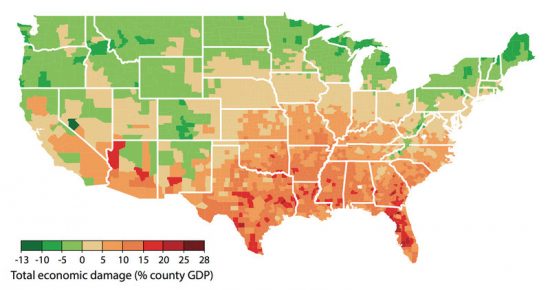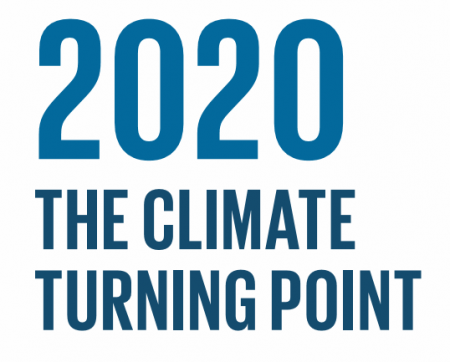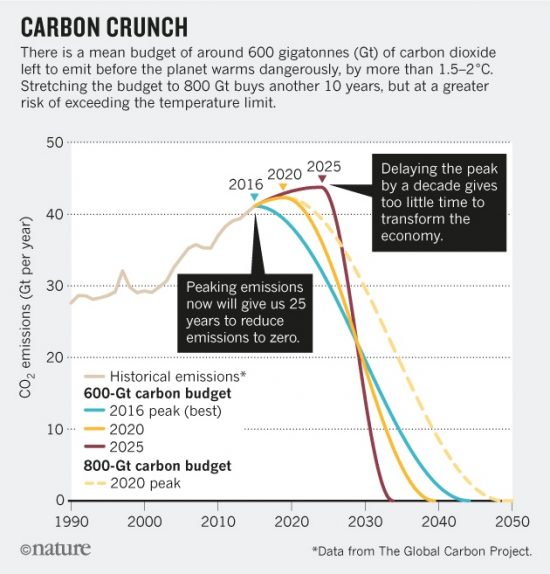June 30, 2017 – Look at the map that appears immediately below this first paragraph. It is an image of the United States that shows county-level economic impacts from emissions of greenhouse gases (GHGs) based on current polluting rates. Those areas of the map in green represent net economic benefits. The areas appearing in shades of brown and red will see negative impacts.

States Solomon Hsiang, lead researcher for the study that produced this map, “Where you are in the country really matters.” He notes that without action on reducing GHGs, climate change will act as a significant force in redistributing wealth, reflected in forecasted county GDP, driving Americans to the North and Northwest from the South and Midwest. That’s because places already hot will become much hotter. And places already dry may become much drier.
This is a century-end forecast and as such doesn’t have the same meaning as something like Mission 2020 (M2020), which focuses on the next three years and what we here on the planet need to do to get CO2 and other GHGs under control.
M2020 is all about tackling the carbon numbers represented in the infographic displayed below. Called the Carbon Crunch it lays out the remaining GHG budget left before we reach levels of CO2 and other global warming gases that will push us beyond the 1.5 to 2 Celsius target limit set by the Paris Climate Agreement.
Our current CO2 global emission rates have flattened over the last few years. But the amount being added equals 41 Gigatons annually and it doesn’t take higher math skills to calculate the number of years remaining before we go past the 600 or 800 Gigaton level. At 600 Gigatons we will hit the 1.5 to 2 Celsius rise in mean global temperature by 2031. We would then have to go cold turkey on CO2, and the other global warming gasses.
M2020 is a set of priorities focused on getting our CO2 house in order. It outlines six specific goals:
- Renewables outcompete fossil fuels to become the predominant new electricity sources worldwide.
- Zero emissions transport becomes the preferred form of all new mobility in the world’s major cities and on transport routes on land, sea and in the air.
- Large-scale deforestation is replaced by large-scale land restoration and agriculture shifts to earth-friendly practices.
- Heavy industry including iron and steel, cement, chemicals and fossil fuels commit to becoming Paris Climate Agreement compliant.
- Cities and states implement policies and regulations to fully decarbonize buildings and infrastructure by 2050.
- Investment in climate action be made beyond the amount of $1 trillion US per year and all financial institutions disclose transition strategies.
Why These Six Targets?
- Power generation today is responsible for 42% of CO2 emissions. Moving to renewables will dramatically reduce that number. A 30% renewable global energy capacity by 2020 would move us in the right direction. So would the elimination of new coal-fired power plant builds, and the planned phase-out of existing ones.
- Transportation is responsible for 14% of total GHG emissions and unlike power generation, emissions are rising as gasoline and diesel-powered vehicles move from the Developed World to the Developing World at an increasing rate. To achieve the turning point, electric vehicle (EV) sales need to ramp up to between 15 and 20% of all new purchases by 2020. Heavy-duty vehicle emission standards need to be tightened. Public transit needs to double. Air transport needs an emission reduction of 20% below 2013 levels per kilometer traveled. And shipping needs to eliminate a significant amount of emissions from commercial fleets on land and sea.
- Restoration of 150 million hectares of degraded land for agricultural use along with sustainable practices will help feed the planet. And forest protection and reforestation will improve the lives of 1.6 billion including more than 2,000 indigenous communities who depend on forests.
- The industrial sector accounts for 21% of total GHG emissions not including heat and electricity which raises their contribution to 32%. Of these iron, steel and cement represent 44% of CO2 emissions from this sector. Decarbonizing requires a halving of emissions by 2050.
- Buildings are responsible for 20% of GHGs. To meet the targeted CO2 and GHG reductions the building sector will have to reduce emissions by 70-80% by 2050. All new buildings will have to meet zero or near-zero emission standards. A goal of an annual upgrading of 3% of all building stock to meet these standards will ensure the targeted reductions can be met.
- Reallocating money to meet carbon reductions will require $200 billion public and $800 billion private investment. Green bond investments will need to grow from $80 billion in 2016 to $800 billion by 2020. Institutions will disclose climate-related financial risks. Fossil fuel subsidies will be eliminated as will investments in the expansion of coal, oil and gas production. And all financial institutions including pension funds, sovereign wealth funds, insurance companies, and banks, will commit to an internal decarbonization strategy for their operations and portfolios.
And the last point, all major economies will implement carbon pricing whether it be a tax or a market scheme such as cap-and-trade.
Is Mission 2020 realistic?
- Not unless governments at all levels, from municipal, county, state, province and nations accept the findings of peer-reviewed science and use them to provide guidance in enacting policy and in assigning necessary funds. The authors of Mission 2020 want scientists to be more effective communicators to counter the climate skeptic media machine funded by those wealthy few who continue to look at their short-term bottom lines. Scientists state the authors, need to “forge connections with leaders from policy, business, and civil society.”
- Not unless mitigation solutions aren’t rapidly scaled up to achieve the objectives laid out above.
- And not unless the public is educated to understand that a “fossil-free economy is already profitable,” with positive gains for health and well-being for all humanity and life on the planet, going well beyond financial benefits. Tackling CO2 and other GHGs represents good business.










